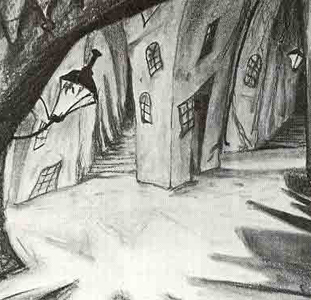Setting

Settings represent more than just the mere spatial location of the plot. They encompass also the time and the social, political, and cultural environment or atmosphere in which the action takes place. As ‘inner space’ they may be images of the characters’ emotional and mental state. They may contrast the plot as independent ‘agents’. This is what is meant when one says that the setting plays a major role in the film.
Settings influence the plot tremendously, are part of it, create an atmosphere and complete the picture. Putting a character into a room or place automatically creates tension. Settings connect, force together, divide or isolate characters; sometimes all in one. They change and transform characters; and once in a while they even seem to come to life and react.
Settings may be distinguished between: internal or external; near or far; cramped or wide; open or closed; above or beneath; remote or central; quiet or noisy; orderly or chaotic; lively or sterile; known or alien.
They may stand for: the new or the old life; refuge or prison; path or one-way-street; open or blocked view; cosiness or discomfort; hide-out or exposition; motion or stillness; protection or danger; wilderness or civilisation; home or the unfamiliar; idyll or underground; desert or forest; island or mountain.
Choosing a setting one should ask why the story should take place at this location and no other and how will this setting support and mirror the plot as well as characters.
 Further Reading
Further Reading
Knauss, Sibylle: Schule des Erzählens. Ein Leitfaden für Roman- und Drehbuchautoren. Berlin 2006.


Comments are closed.